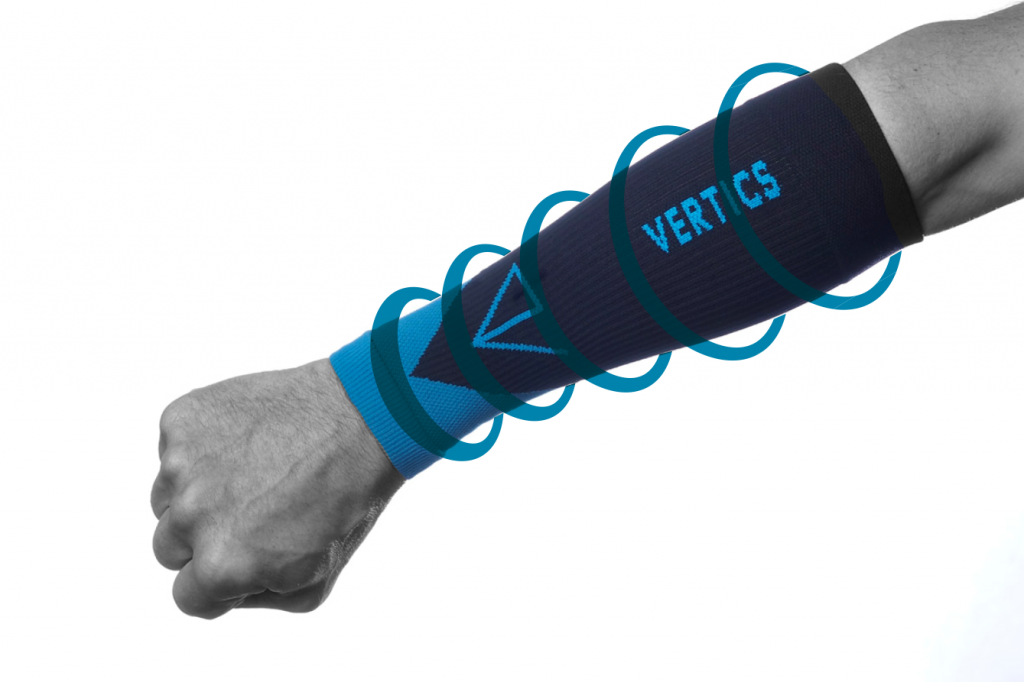Deutsch (German)
Français (French)
Italiano (Italian)
Español (Spanish)
VERTICS. Sleeves vs. Forearm Pump (scroll down for german version)
According to the preliminary evaluation of our survey on the effectiveness of VERTICS. Sleeves we already see it as confirmed that VERTICS. Sleeves reduce the forearm pump. More than 70% of respondents answered “yes” to the question about reduced arm pump when using our compression sleeves.
The phenomenon of arm pump, commonly referred to as compartment syndrome, is probably as old as mankind itself. Whether the Neanderthal has handled stone tools or the climber struggles on pumping routes or the MotoX rider clings to the grips of his handlebars, the pump is common to all.
What causes this effect? There are many reasons for this, but essentially the blood stasis in the forearm muscles is probably responsible. With increasing and permanent stress on the forearm due to complex hand movements, more blood flows into the muscle, which causes the muscle tissue to swell. The muscle tissue now presses on the muscle skin or fascia. The fascia consists of a cartilage-like tissue, firm but not very elastic. Therefore, the muscle cannot expand further and then literally squeezes its own blood vessels. The result is a reduced or completely stopped blood flow, hyperacidity and cramping of the forearms, up to numbness of the hand or individual fingers. If the return flow of the blood is inhibited, the waste products that are produced during muscle work, such as lactate, are not sufficiently pumped out. The result is hyperacidity of the muscle, i.e. the pH value drops and inhibits muscle contraction. So there are many factors that promote the pump in the arms. It is still unclear why this effect occurs less frequently in some people, or is sometimes particularly strong or sometimes weaker. This certainly depends on the current metabolism and the electrolyte balance of the body at the moment of exertion.
What can you do about the forearm pump? MotoX riders and motorcycle racers go so far as to have the fascia surgically incised or removed so that the muscle has more room to expand. However, the success of this method is controversial, as it often leads to further surgical interventions. Regular training is always good, of course, but be careful!
Muscle-building exercises are counterproductive in this case.
It is better to do regular, short training with isometric exercises, i.e. holding exercises. Climbers often use training balls, rings, spring-loaded holds or modelling clay with different degrees of hardness and press them together with their fingers at intervals. However, it is better to hold the load for some time and not to “pump”. Campus board and shimmy exercises can even worsen the condition here.

Become VERTICS. Sleeves Compression gauntlets worn at the beginning of training can contribute to an accelerated return transport of venous blood, so that the pump is delayed and reduced. If the arms should then nevertheless converge at some point, VERTICS. Sleeves to faster recovery and relaxation of the forearm muscles.
Source: Motorsport-Magazin.com
Full article (german) at http://www.motorsport-magazin.com/motogp/news-205559-was-hat-es-mit-dem-arm-pump-auf-sich/
Although this is about motorcycle racing, the load on the forearm muscles and the arm pump is comparable to climbing.
After preliminary analysis of our survey on the effectiveness of VERTICS. Sleeves we see already as confirmed that VERTICS. Sleeves can reduce the pump effect in the forearms. More than 70% of respondents answered the question of reduced arm pump when using our compression sleeves with “Yes”.
The phenomenon of arm pump, also called compartment syndrome, is probably as old as human itself. Whether Neanderthals has handled with stone tools or a climber does pumpin’ routes or MotoX rider clings the steering, they all share the pump.
Which is this effect? There are many causes for the pump, but essentially the congestion in the forearm muscles is probably responsible. With an increasing and constant stress of the forearm by complex hand movements, the blood flow into the muscle is also increased so that it swells. The muscle now presses on the muscle fascia. The fascias are made of a cartilaginous tissue, firmly but poorly stretchable. Therefore, the muscle can ́t continue to expand and presses even on the blood vessels. The result is a reduced or completely stopped bloodstream, acidification and cramping of forearms to numbness of the hands or individual fingers. If the backflow of blood is inhibited, the waste products that are produced during muscle work, such as Lactate, are insufficient pumped out. The result is an over-acidification of the muscle, the pH decreases and inhibits muscle contraction. So it come together many factors that increase the pump in the forearms. Unclear so far why this effect in some people is less common, or even particularly strong or even stronger. This certainly depends with the current metabolism and the Elektrolyth balance of the body at the moment of impact.
What can be done to prevent the forearm pump? MotoX rider and motorcycle racer go so far as the fascia carve surgically or remove so the muscle has more space to expand. The success of this method is controversial because it often leads to additional surgical interventions. Regular exercise is of course always good, but be careful! Toning exercises are counterproductive in this case. Better is a regular, short training with isometric exercises, thus holding exercises. Climbers often use training balls, rings, suspended handles or clay with different degrees of hardness and press this intermittently with your fingers together. Campusboard and Shimmy are short interval excercises with maximum load and are rather counterproductive in this case. It is better, however, to keep the load for some time and not “pump” to.
Are VERTICS. Sleeves compression cuffs worn at the beginning of the training, they can contribute to an accelerated repatriation of venous blood, so that the pump is delayed and reduced. Should the arms still running in pump at some point, VERTICS. Sleeves help in faster recovery and relaxation of forearm muscles.
